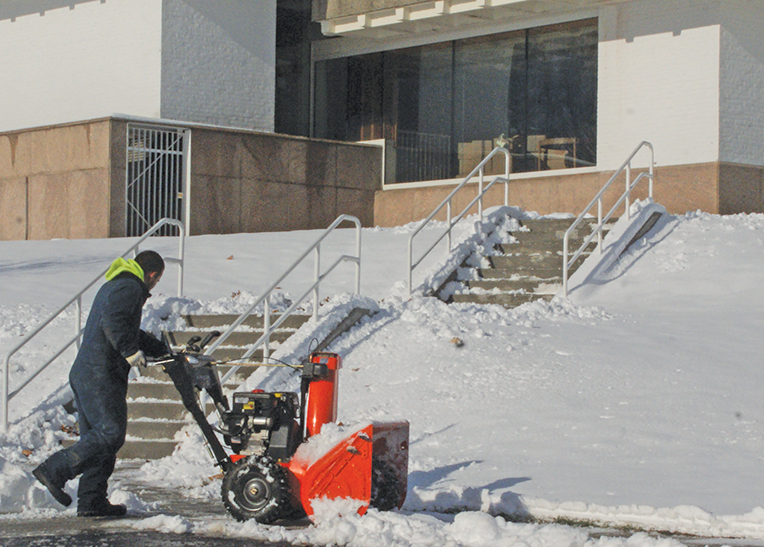
Photo by Lester Smith
On Christmas Day, a snow removal contractor completes his task of clearing the morning snow from the sidewalks and the stairs of the Kent Memorial Library. Library patrons aren’t yet welcome, but work continues in the buildng, and the paths are occasionally used for a shortcut from the Main Street sidewalk to Bank Lane.
The Permanent Building Commission has been struggling with the issue for several years, but in Suffield’s long journey through the PCB problems of the Kent Memorial Library, there now appears to be some light at the end of the tunnel. Town Facilities Manager Julie Oakes reported on January 11 to the commission that the important report to the EPA is nearly ready for issuance. This report will describe the results of the successful pilot test of a remediation method. It will also ask for approval of a draft of the request for proposal to be sent to potential contractors, defining the work required throughout the building and asking for cost quotations. The proposal request was being reviewed by Town Attorney Derek Donnelly.
Oakes has been working closely with Bob May, who was reviewing the report. He is the president of consulting engineering firm Fuss and O’Neil, with headquarters in Manchester, and is considered to be the state’s most knowledgeable person regarding PCB and its remediation. He has been intimately involved in the recent pilot tests in the library gallery and subsequent deliberations on what to do now and how to contract for the work.
The proposed project is complex and extensive but consists mostly of scraping and recoating the ceilings of the original sections of the building. The ceilings are believed to be the source of the airborne PCB discovered near the completion of the big project for constructing a new entrance and elevator, renewing the old building’s HVAC and electrical systems, and installing new windows. The ceiling remediation requires removing the sound insulation tiles deep in the waffled recesses and clearing off the many cable conduits and water pipes. Also, the old wooden shelving must be removed from the walls so the walls can be cleaned and painted for “encapsulation.” The parquet floors must be sanded and refinished, and certain regions of carpet tiles are to be taken up and cleaned. It is thought that this work might cost as much as $100,000 a month, depending on the size of the work force; the time required is uncertain.
Separate from the building remediation is the matter of some 60,000 books that are still shelved in the library. (They had been covered in plastic, but were unwrapped many months ago when reopening seemed imminent.) They must be vacuumed and wiped. When the library reopens, eventually, the 20,000 or so books that were chosen for current circulation from the temporary library will be returned and merged. The logistics of all this are as yet undefined, but Oakes has discovered a company experienced with related activities dealing with library books.
Julie Oakes also added a little surprise: she said that recent scrape tests had shown that the old granite slabs on the lower sections of the building’s exterior have shown PCB contamination. It was known from the beginning that the old window caulking was a PCB source, and all of that was removed, along with selected regions of old brick below and alongside the windows. Evidently those precautions were inadequate. Bob May is considering how to respond to this challenge.
On the positive side, the HVAC system is reported to be working well.